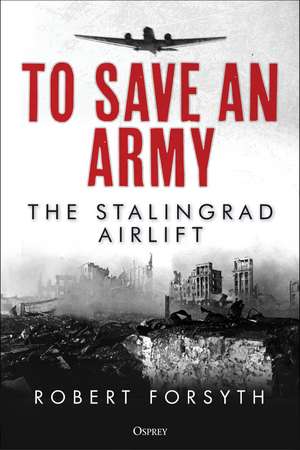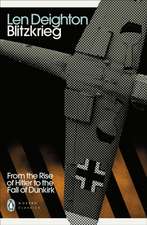To Save An Army: The Stalingrad Airlift
Autor Robert Forsythen Limba Engleză Hardback – 9 noi 2022
Preț: 124.53 lei
Preț vechi: 171.59 lei
-27% Nou
Puncte Express: 187
Preț estimativ în valută:
23.83€ • 24.41$ • 19.82£
23.83€ • 24.41$ • 19.82£
Carte disponibilă
Livrare economică 26 februarie-12 martie
Livrare express 11-15 februarie pentru 88.94 lei
Preluare comenzi: 021 569.72.76
Specificații
ISBN-13: 9781472845412
ISBN-10: 1472845412
Pagini: 352
Ilustrații: A 32-page plate section with both colour and black and white images.
Dimensiuni: 153 x 234 x 37 mm
Greutate: 0.73 kg
Editura: Bloomsbury Publishing
Colecția Osprey Publishing
Locul publicării:London, United Kingdom
ISBN-10: 1472845412
Pagini: 352
Ilustrații: A 32-page plate section with both colour and black and white images.
Dimensiuni: 153 x 234 x 37 mm
Greutate: 0.73 kg
Editura: Bloomsbury Publishing
Colecția Osprey Publishing
Locul publicării:London, United Kingdom
Caracteristici
Features rare, unpublished and graphic descriptions of the battle from senior German commanders, plus detailed day-to-day analysis of operations and descriptions of the aircraft deployed.
Notă biografică
Robert Forsyth is an author, editor and publisher, specialising in military aviation and military history. He is the author of over 25 titles for Osprey Publishing, on the aircraft, units and operations of the Luftwaffe, including Luftwaffe Special Weapons 192-45 and DUEL 97 Tempest V vs Fw 190D-9: 1944-45.
Cuprins
Part OneConquest· The Demyansk and Kholm airlifts - dangerous precedents, 1941-42· A summary of the advance of Army Group South (later Army Groups A and B) towards the Don from July 1942 and war aims (to September 1942)· The role and status of the Luftwaffe in support of German war aims in southern Russia from the summer of 1942, with focus on the Transportverbände, biographies of the airlift senior commanders such as Milch, von Richthofen, Fiebig, Pickert and Morzik, and the effect of their backgrounds and personalities on events; the transport units, their structures and the Luftwaffe's multi-front commitments· Detailed descriptions of the six principal transport aircraft used in the Stalingrad airlift: Junkers Ju 52/3m - Heinkel He 111 - Heinkel He 177 - Junkers Ju 290 - Focke-Wulf Fw 200 - Junkers Ju 86 Part TwoCrisis· A summary of Zhukov's counter-attack, Operation Uranus, launched on 19 November 1942, and the encirclement of Sixth Army four days later· The decision by Hitler, Göring, Jeschonnek and the German high command to supply Sixth Army by air· The commencement of airlift (Phase 1 to mid-December), with flights landing at Gumrak and Pitomnik airfields inside the pocket carrying mainly fuel and ammunition; day-by-day description of events, command decisions, flights, effect of weather, enemy reaction and movement, analysis of supplies and tonnages, serviceability, units deployed, weather conditions etc. Mainly fuel and ammunition to 19 December based on Sixth Army requests· The stalling of the Hoth relief effort (Operation Winter Storm) by 23 December Part Three Catastrophe· Phase 2 and the climactic, doomed airlift from 24 December, with even the main Luftwaffe airlift depot base at Tatsinskaya under threat. Day-by-day description of events, command decisions, flights, effect of weather, enemy reaction and movement· From 26 December onwards the supply of food becomes the priority over ammunition and fuel· On 12 January, Pitomnik airfield in the pocket is lost; landings increasingly give way to air-drops as conditions worsen. Gumrak airfield lost on 22 January· Detail will range from the command decisions in Berlin, to air fleet and corps command-level, to operations by individual transport unitsAftermath and conclusionsAppendicesIndex
Recenzii
Robert Forsyth's skill at unearthing rare primary material has produced a remarkable and revelatory narrative. It gives a true insight into the near Herculean effort of the Luftwaffe to keep the trapped Sixth Army alive in history's bloodiest campaign.
In this detailed account of the doomed attempt to keep the encircled German Sixth Army alive in Stalingrad by air, Robert Forsyth gives readers a fresh look at the precedents that led to the fatal decision to rely on an airlift and the tragedy that then unfolded. For anyone interested in both the detail and the difficulties of mounting the Stalingrad airlift, this book is essential reading.
To Save An Army: The Stalingrad Airlift is easily the most detailed, day-by-day narrative of that critical moment in the Second World War which has been written to date. . [It] is a rich, data-driven military history, interlaced with compelling personal vignettes from pilots, aircrew, staff officers and evacuated soldiers.
It is military history at its best.
A highly impressive work in all regards, and an essential read.
There is no greater compliment than to say this is a worthy companion to Antony Beevor's acclaimed history of the ground battle, Stalingrad.
A title which is absolutely essential reading for anyone interested in the Battle of Stalingrad and operations on the Eastern Front, generally.
In this detailed account of the doomed attempt to keep the encircled German Sixth Army alive in Stalingrad by air, Robert Forsyth gives readers a fresh look at the precedents that led to the fatal decision to rely on an airlift and the tragedy that then unfolded. For anyone interested in both the detail and the difficulties of mounting the Stalingrad airlift, this book is essential reading.
To Save An Army: The Stalingrad Airlift is easily the most detailed, day-by-day narrative of that critical moment in the Second World War which has been written to date. . [It] is a rich, data-driven military history, interlaced with compelling personal vignettes from pilots, aircrew, staff officers and evacuated soldiers.
It is military history at its best.
A highly impressive work in all regards, and an essential read.
There is no greater compliment than to say this is a worthy companion to Antony Beevor's acclaimed history of the ground battle, Stalingrad.
A title which is absolutely essential reading for anyone interested in the Battle of Stalingrad and operations on the Eastern Front, generally.


